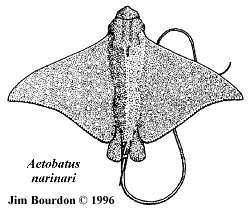| |

Aetobatus is a genus of near-shore rays which are represented in all subtropical and tropical oceans. Compagno (1999) recognized three species
- Aetobatus narinari (EUPHRASEN, 1790) —Spotted eagle ray.
A common circumglobal tropical and subtropical species which frequents shallow inshore waters including coral reefs. These are large rays reaching three meters and over 200kg.
- Aetobatus flagellum (BLOCH & SCHNEIDER, 1801)
A small (72.0 cm DW) benthopelagic Indo-West Pacific species, it inhabits inshore often brackish tropical waters.
- Aetobatus ocellatus (KUHL & VAN HASSELT, 1823)
A poorly known benthopelagic species reported from tropical waters of the Indian Ocean (India, Java and Indonesia).
 Although similar in appearance to other myliobatoids, these rays can be distinguished by their thick bodies. A. narinari has the typical myliobatid diamond-shaped disk: very long, thin tail and one or more barbs just behind the dorsal fin at the base of the tail. The shovel-shaped snout with a duck-billed mouth is used to dig up mollusks and other animals. Seasonally swimming in groups, it also feeds on worms, crustaceans, cephalopods and small fishes. A. narinari is suspected of crossing ocean basins.
Although similar in appearance to other myliobatoids, these rays can be distinguished by their thick bodies. A. narinari has the typical myliobatid diamond-shaped disk: very long, thin tail and one or more barbs just behind the dorsal fin at the base of the tail. The shovel-shaped snout with a duck-billed mouth is used to dig up mollusks and other animals. Seasonally swimming in groups, it also feeds on worms, crustaceans, cephalopods and small fishes. A. narinari is suspected of crossing ocean basins.
 Aetobatus employs a highly refined grinding dentition wherein the tooth plate has been reduced to a single file of broad, high-crowned and well-interlocked teeth. Isolated Aetobatus teeth can be readily identified by their large size, root design and crown shape. The crowns lack the hexagonal shape associated with other myliobatids -- the lateral margins are smoothly curved and directed rearward. Because the species has a single file, all teeth are elongated. The upper and lower teeth have distinctly different shapes permitting easy determination of jaw source. The roots are quite distinctive with the strong, lingual displacement of the laminae and the strongly sloped labial face of the roots.
Aetobatus employs a highly refined grinding dentition wherein the tooth plate has been reduced to a single file of broad, high-crowned and well-interlocked teeth. Isolated Aetobatus teeth can be readily identified by their large size, root design and crown shape. The crowns lack the hexagonal shape associated with other myliobatids -- the lateral margins are smoothly curved and directed rearward. Because the species has a single file, all teeth are elongated. The upper and lower teeth have distinctly different shapes permitting easy determination of jaw source. The roots are quite distinctive with the strong, lingual displacement of the laminae and the strongly sloped labial face of the roots.
|